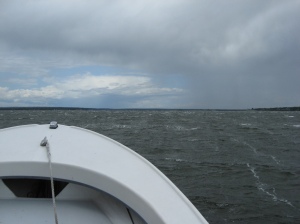 |
| Sudden Squall |
The north western part of Greenwich Bay was found to be just at the hypoxic level at 2.9mg/L of dissolved oxygen. However, the southern parts of Greenwich Bay and much of the rest of the Bay was well mixed and oxygen levels were sufficiently high. The squall likely mixed the water and oxygenated it further.
Marine animals breath oxygen too and when oxygen levels drop below 3mg/L there is not enough oxygen to go around. Creatures that live on the bottom of the bay such as oysters, littlenecks, and marine worms are at a greater risk during hypoxic events because they cannot move to a different area. Schooling fish such as menhaden are also affected by hypoxia because they are often chased into coves by predators such as striped bass and the school will use up the oxygen faster than it can be produced by photosynthesis or mixed into the water at the surface from the air.
Our next water quality survey will occur in the second week of July, however we hope to do a video survey next week to look at the sediments throughout Greenwich Bay.
 |
| Our captain Heather and intern Bart. |
 |
| Lesley and Becca work on gathering the data. |
No comments:
Post a Comment